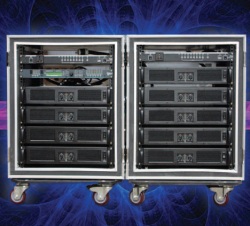
A source that cannot run continuously without overheating may be given a duty cycle rating. Playing a repetitive waveform (like a kick drum) is like pumping the brakes on your car. The power and heat production are reduced. That’s a good thing, since otherwise we’d be tripping circuit breakers and burning voice coils.
In contrast, the largest power ratings on an amplifier spec sheet result from “Burst testing.” This is a method developed for measuring cell phone signals, and it is also used on power amplifiers. A burst test hits the amplifier with a signal that only lasts a few milliseconds. These bursts produce some very high amplitude peaks, but only for a very short period of time.
Looked at another way, burst testing can prevent the circuit breaker from tripping (a good thing) and allow our 2,400-watt amplifier to drive a 2-ohm load. This theoretically doubles the power to nearly 5 kW from a single amplifier channel. Is this a legitimate power rating for the amplifier?
The moment-by-moment voltage amplitude values of an audio waveform can be very high. Multiplying the instantaneous voltage by the instantaneous current yields the instantaneous power (and some impressive numbers!). Instantaneous power is a means to an end, not the end itself. It must be integrated over time to find the root-mean-square voltage and the average power (a less impressive number!).
We can all pass our finger quickly through the flame of a candle without being burned, but we wouldn’t boast about being able to “handle” the heat of the flame. The short-term transients in the audio signal may not pose a thermal danger to the transducer, so technically they are not over-powering it. They may, however, cause excessive excursion, which is another failure mode of loudspeakers.
While burst signals can have very high amplitudes, they are quite short in duration. The waveform produced by a kick drum is made up of multiple frequencies that are not phase coherent due to the non-linear phase response of the subwoofer. This makes the crest factor high, or looked at another way, the duty cycle low (should drummers have duty cycle ratings?).
Either way, the power output from a kick drum is not all that high. A far more punishing waveform would be the continuous sine or square wave output from a synthesizer. This is the only way that you will challenge an amplifier to produce its full rated power, and you may burn up your subwoofer in the process.
Don’t get me wrong. It is a good thing for an amplifier to be able to produce waveforms with very high instantaneous power.
